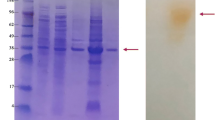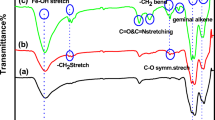Abstract
Peroxidases (EC 1.11.1.7) have enormous biotechnological applications. Usage of more abundant, basic isoforms of peroxidases in diagnostic kits and/or in immunochemistry has led to under exploitation and disregard of horseradish peroxidase (HRP) acidic isoforms. Therefore, acidic horseradish peroxidase (HRP-A) isoenzyme was used for the preparation of a biocatalyst with improved ability in dye decolorization. Ten biocatalysts were prepared by covalent binding of enzyme to chitosan and alginate, adsorption followed by cross-linking on inorganic support (aluminum oxide), and encapsulation in spherical calcium alginate beads via polyethylene glycol. Model dyes of 50 to 175 mg l−1 were removed by the biocatalysts. Among the tested biocatalysts, the three with the highest specific activity and biodegradation rate were further studied (Chitosan-HRP, Al-Gel-HRP and Al-HRP-Gel). The impact of hydrogen peroxide concentration on dye decolorization was examined on the Chitosan-HRP biocatalyst, since the HRP is susceptible to inhibition/inactivation by high H2O2. On the other hand, H2O2 is needed as a co-substrate for the HRP, and the H2O2/dye ratio can greatly influence decolorization efficiency. Concentrations of H2O2 ranging from 0.22 to 4.4 mM showed no difference in terms of impact on the biocatalyst decolorization efficiency. The high decolorization efficiency of the biocatalysts was validated by the removal of 25 and 100 mg l−1 anthraquinone (Remazol Brilliant Blue R (RBBR)), triphenylmethane (Coomassie Brilliant Blue (CBB)), acridine (Acridine Orange (AO)), and formazan metal complex dye (Reactive Blue 52 (RB52)). After the seven consecutive decolorization cycles, the decolorization was still 53, 78, and 67% of the initial dye for the Al-HRP-Gel, Al-Gel-HRP, and Chitosan-HRP immobilizate, respectively. The results obtained showed potential of otherwise neglected acidic HRP isoforms as a cost-effective biocatalyst with significant potential in wastewater dyestuff treatment.








Similar content being viewed by others
References
Alemzadeh I, Nejati S (2009) Phenols removal by immobilized horseradish peroxidase. J Hazard Mater 166:1082–1086. doi:10.1016/j.jhazmat.2008.12.026
Ali H (2010) Biodegradation of synthetic dyes—a review. Water Air Soil Pollut 2013:251–273. doi:10.1007/s11270-010-0382-4
Ali L, Algaithi R, Habib HM et al (2013) Soybean peroxidase-mediated degradation of an azo dye—a detailed mechanistic study. BMC Biochem 14:35. doi:10.1186/1471-2091-14-35
Arslan M (2011) Immobilization horseradish peroxidase on amine-functionalized glycidyl methacrylate-g-poly(ethylene terephthalate) fibers for use in azo dye decolorization. Polym Bull 66:865–879. doi:10.1007/s00289-010-0316-8
Balakrishnan B, Lesieur S, Labarre D, Jayakrishnan A (2005) Periodate oxidation of sodium alginate in water and in ethanol-water mixture: a comparative study. Carbohydr Res 340:1425–1429. doi:10.1016/j.carres.2005.02.028
Baynton KJ, Bewtra JK, Biswas N, Taylor KE (1994) Inactivation of horseradish peroxidase by phenol and hydrogen peroxide: a kinetic investigation. Biochim Biophys Acta 1206:272–278. doi:10.1016/0167-4838(94)90218-6
Bradford MM (1976) A rapid and sensitive method for the quantitation microgram quantities of protein utilizing the principle of protein-dye binding. Anal Biochem 72:248–254
Celebi M, Kaya MA, Altikatoglu M (2013) Enzymatic decolorization of anthraquinone and diazo dyes using horseradish peroxidase enzyme immobilized onto various polysulfone supports. Appl Biochem Biotechnol 171:716–730. doi:10.1007/s12010-013-0377-x
Chairin T, Nitheranont T, Watanabe A et al (2013) Biodegradation of bisphenol A and decolorization of synthetic dyes by laccase from white-rot fungus, Trametes polyzona. Appl Biochem Biotechnol 169:539–545. doi:10.1007/s12010-012-9990-3
Cheng J, Ming Yu S, Zuo P (2006) Horseradish peroxidase immobilized on aluminum-pillared interlayered clay for the catalytic oxidation of phenolic wastewater. Water Res 40:283–290. doi:10.1016/j.watres.2005.11.017
Eryomin AN, Makarenko MV, Budnikova LP (2005) Polymerization of horseradish peroxidase in the presence of inorganic adsorbents. Appl Biochem Microbiol 41:383–391. doi:10.1007/s10438-005-0057-x
Eş I, Vieira JDG, Amaral AC (2015) Principles, techniques, and applications of biocatalyst immobilization for industrial application. Appl Microbiol Biotechnol 99:2065–2082. doi:10.1007/s00253-015-6390-y
Gómez JL, Bódalo A, Gómez E et al (2006) Immobilization of peroxidases on glass beads: an improved alternative for phenol removal. Enzym Microb Technol 39:1016–1022. doi:10.1016/j.enzmictec.2006.02.008
Gomez CG, Rinaudo M, Villar MA (2007) Oxidation of sodium alginate and characterization of the oxidized derivatives. Carbohydr Polym 67:296–304. doi:10.1016/j.carbpol.2006.05.025
Hiner ANP, Hernandez-Ruiz J, Rodriguez-Lopez JN et al (2001) The inactivation of horseradish peroxidase isoenzyme A2 by hydrogen peroxide: an example of partial resistance due to the formation of a stable enzyme intermediate. JBIC, J Biol Inorg Chem 6:504–516. doi:10.1007/s007750100219
Husain Q (2010) Peroxidase mediated decolorization and remediation of wastewater containing industrial dyes: a review. Rev Environ Sci Biotechnol 9:117–140. doi:10.1007/s11157-009-9184-9
Husain S, Jafri F, Saleemuddin M (1996) Immobilization and stabilization of horseradish peroxidase isoforms. Biochem Mol Biol Int 40:1–11
Jamal F (2011) Functional suitability of soluble peroxidases from easily available plant sources in decolorization of synthetic dyes. In: Hauser P (ed) Advances in Treating Textile Effluent, InTech, pp 49–72
Karim Z, Adnan R, Husain Q (2012) A β-cyclodextrin-chitosan complex as the immobilization matrix for horseradish peroxidase and its application for the removal of azo dyes from textile effluent. Int Biodeterior Biodegrad 72:10–17. doi:10.1016/j.ibiod.2012.04.008
Koyama K, Seki M (2004) Cultivation of yeast and plant cells entrapped in the low-viscous liquid-core of an alginate membrane capsule prepared using polyethylene glycol. J Biosci Bioeng 97:111–118. doi:10.1263/jbb.97.111
Krainer FW, Glieder A (2015) An updated view on horseradish peroxidases: recombinant production and biotechnological applications. Appl Microbiol Biotechnol 99:1611–1625. doi:10.1007/s00253-014-6346-7
Kumar V, Misra N, Goel K, Thakar R (2015) A horseradish peroxidase immobilized radiation grafted polymer matrix : a biocatalytic system for dye waste water treatment. RSC Adv 6:2974–2981. doi:10.1039/C5RA20513A
Li F, Ding C (2011) Adsorption of Reactive Black M- 2 R on Different Deacetylation Degree Chitosan. J Eng Fiber Fabr 6:25–31
Lončar N, Božić N, Andelković I et al (2011) Removal of aqueous phenol and phenol derivatives by immobilized potato polyphenol oxidase. J Serbian Chem Soc 76:513–522. doi:10.2298/JSC100619046L
Marchis T, Avetta P, Bianco-prevot A et al (2011) Oxidative degradation of Remazol Turquoise Blue G 133 by soybean peroxidase. J Inorg Biochem 105:321–327. doi:10.1016/j.jinorgbio.2010.11.009
Mateo C, Palomo JM, Fernandez-Lorente G et al (2007) Improvement of enzyme activity, stability and selectivity via immobilization techniques. Enzym Microb Technol 40:1451–1463. doi:10.1016/j.enzmictec.2007.01.018
Milovanović A, Božić N, Vujčić Z (2007) Cell wall invertase immobilization within calcium alginate beads. Food Chem 104:81–86. doi:10.1016/j.foodchem.2006.11.001
Mohan SV, Prasad KK, Rao NC, Sarma PN (2005) Acid azo dye degradation by free and immobilized horseradish peroxidase (HRP) catalyzed process. Chemosphere 58:1097–1105. doi:10.1016/j.chemosphere.2004.09.070
Munjal N, Sawhney SK (2002) Stability and properties of mushroom tyrosinase entrapped in alginate, polyacrylamide and gelatin gels. Enzym Microb Technol 30:613–619. doi:10.1016/S0141-0229(02)00019-4
Nitheranont T, Watanabe A, Suzuki T et al (2011) Decolorization of synthetic dyes and biodegradation of bisphenol A by laccase from the edible mushroom, Grifola frondosa. Biosci Biotechnol Biochem 75:1845–1847. doi:10.1271/bbb.110329
Pramparo L, Stüber F, Font J et al (2010) Immobilisation of horseradish peroxidase on Eupergit®C for the enzymatic elimination of phenol. J Hazard Mater 177:990–1000. doi:10.1016/j.jhazmat.2010.01.017
Regalado C, García-Almendárez BE, Duarte-Vázquez MA (2004) Biotechnological applications of peroxidases. Phytochem Rev 3:243–256
Šekuljica N, Prlainović N, Jovanović JR et al (2016) Immobilization of horseradish peroxidase onto kaolin. Bioprocess Biosyst Eng 39:461–472. doi:10.1007/s00449-015-1529-x
Shaffiqu TS, Roy J, Nair RA, Abraham TE (2002) Degradation of textile dyes mediated by plant peroxidases. Appl Biochem Biotechnol 102–103:315–326
Shakeri M, Shoda M (2007) Change in turnover capacity of crude recombinant dye-decolorizing peroxidase (rDyP) in batch and fed-batch decolorization of Remazol Brilliant Blue R. Appl Microbiol Biotechnol 76:919–926. doi:10.1007/s00253-007-1042-5
Sheldon RA (2007) Enzyme immobilization: the quest for optimum performance. Adv Synth Catal 349:1289–1307. doi:10.1002/adsc.200700082
Shukla SP, Modi K, Ghosh PK, Devi S (2004) Immobilization of horseradish peroxidase by entrapment in natural polysaccharide. J Appl Polym Sci 91:2063–2071. doi:10.1002/app.13269
Soares CMF, dos Santos OA, de Castro HF et al (2006) Characterization of sol-gel encapsulated lipase using tetraethoxysilane as precursor. J Mol Catal B Enzym 39:69–76. doi:10.1016/j.molcatb.2006.01.005
Uzun I (2006) Kinetics of the adsorption of reactive dyes by chitosan. Dyes Pigments 70:76–83. doi:10.1016/j.dyepig.2005.04.016
Valderrama B, Ayala M, Vazquez-Duhalt R (2002) Suicide inactivation of peroxidases and the challenge of engineering more robust enzymes. Chem Biol 9:555–565
Vujcic Z, Janovic B, Loncar N et al (2014) Exploitation of neglected horseradish peroxidase izoenzymes for dye decolorization. Int Biodeterior Biodegradation 97:124–127. doi:10.1016/j.biod.2014.10.007
Wang P, Fan X, Cui L et al (2008) Decolorization of reactive dyes by laccase immobilized in alginate/gelatin blent with PEG. J Environ Sci 20:1519–1522. doi:10.1016/S1001-0742(08)62559-0
Zaharia C, Suteu D (2012) Textile Organic Dyes – Characteristics, Polluting Effects and Separation/Elimination Procedures from Industrial Effluents – A Critical Overview. In: Puzyn T (ed) Organic Pollutants Ten Years After the Stockholm Convention - Environmental and Analytical Update, InTech, pp 55–86. doi:10.5772/32373
Zille A, Tzanov T, Gübitz GM, Cavaco-Paulo A (2003) Immobilized laccase for decolourization of reactive Black 5 dyeing effluent. Biotechnol Lett 25:1473–1477. doi:10.1023/A:1025032323517
Acknowledgements
This work was supported by the Serbian Ministry of Education, Science, and Technological Development (Grant No. 172048).
Author information
Authors and Affiliations
Corresponding author
Ethics declarations
Conflict of interest
The authors declare that they have no conflict of interest.
Additional information
Responsible editor: Gerald Thouand
Rights and permissions
About this article
Cite this article
Janović, B.S., Mićić Vićovac, M.L., Vujčić, Z.M. et al. Tailor-made biocatalysts based on scarcely studied acidic horseradish peroxidase for biodegradation of reactive dyes. Environ Sci Pollut Res 24, 3923–3933 (2017). https://doi.org/10.1007/s11356-016-8100-4
Received:
Accepted:
Published:
Issue Date:
DOI: https://doi.org/10.1007/s11356-016-8100-4




